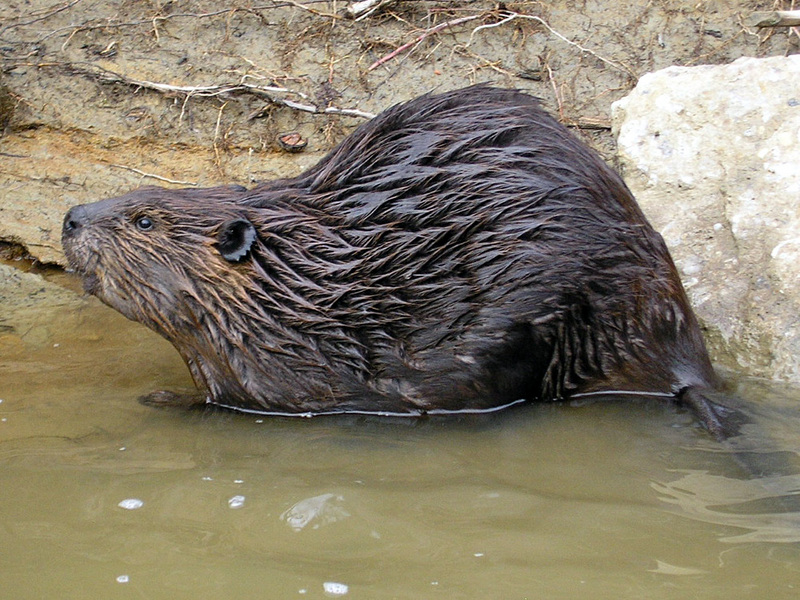American Beaver (Castor canadensis) - Wiki American Beaver
From Wikipedia, the free encyclopedia
[Photo] "I came across this handsome animal (Castor canadensis) on a recent fishing excursion. Unfortunately, I could not get a better shot of the tail, which is very broad and flat." Source: This image was originally posted to Flickr as Grand River Beaver - Painesville, Ohio. Date May 24, 2006. Author: LASZLO ILYES (laszlo-photo) from Cleveland, Ohio, USA
The North American Beaver (Castor canadensis) is a large semi-aquatic rodent native to Canada, most of the United States and parts of northern Mexico. Its fur is dark brown. It has a rounded head, a large flat paddle-shaped tail and webbed hind feet. The unwebbed front paws are smaller, with claws. This is the largest rodent found in North America and the second largest rodent in the world (the largest rodent being the South American capybara).
Beavers are mainly active at night. They are excellent swimmers but are more vulnerable on land and tend to remain in the water as much as possible. They are able to remain submerged for up to 15 minutes. A scent gland near their genitals secretes an oily substance known as castoreum which is used to waterproof its fur. A thick layer of fat under its skin insulates the beaver from its cold water environment. The eyes are covered by a nictitating membrane which allows the beaver to see underwater. Their nostrils and ears are sealed while submerged.
They sometimes make their home in a river bank, but they are best known for building dams across streams and constructing their "lodge" in the artificial pond which forms. The entrance to the lodge or burrow is located underwater. In the event of danger, a beaver slaps its tail on the water to warn other family members.
Research has shown that dam-building behaviour and choice of dam location is triggered by the sound of flowing water.
The dam is constructed using sections of deciduous trees, especially birch, aspen, willow and poplar. This vegetation is also an important part of the beaver's diet. The trees are cut down using their strong incisor teeth. Their front paws are used for digging and carrying and placing materials.
During the summer, beavers also eat grasses, cattails, water lilies and other aquatic plants.
Besides providing a safe home for the beaver, beaver ponds also provide habitat for waterfowl and other aquatic animals. Their dams help reduce soil erosion and can help reduce flooding.
Beavers usually mate for life. The young beaver "kits" typically remain with their parents for up to two years.
Threats
These animals are considered pests in some parts of their range because their dams can cause flooding in nearby areas. They are incredibly persistent in repairing any damage to the dam and the only way to make them stop is to remove them from the location.
These animals are often trapped for their fur. During the early 19th century, trapping eliminated this animal from most of its original range. The beaver furs were used to make clothing and top-hats. Much of the early exploration of North America was driven by the quest for this animal's fur. Native peoples and early settlers also ate this animal's meat. The current beaver population has been estimated to be 10 to 15 million; there may have originally been ten times that many beavers in North America before the days of the fur trade.
Other predators include the Coyote, the Gray Wolf, the Bobcat and the Red Fox.
An emerging problem is the descendants of an introduced population in Tierra del Fuego, Argentina. The escapees from a farmed population of 25 animals has bloomed to an estimated 100,000; the drastically different ecosystem has led to incredible environmental damage, as the ponds created by the beavers have no ecological purpose (wetlands do not form there as they do in the beavers' native territory) and there are no native, large predators. They have also been found to cross saltwater spaces to islands northward; a possible encroachment on the mainland has naturalists highly concerned.
The Beaver as Symbol
One of the national symbols of Canada, the beaver is depicted on the Canadian five-cent piece and was on the first Canadian postage stamp, the Three Penny Beaver. It is also the state animal of Oregon and New York, and a common school emblem for engineering schools, including the California Institute of Technology and the Massachusetts Institute of Technology. The beaver also appears in the coat of arms of the London School of Economics.
In parts of North America, fried dough pastries known as "Beaver Tails" are eaten at outdoor events.
http://en.wikipedia.org/wiki/American_Beaver
| The text in this page is based on the copyrighted Wikipedia article shown in above URL. It is used under the GNU Free Documentation License. You may redistribute it, verbatim or modified, providing that you comply with the terms of the GFDL. |
